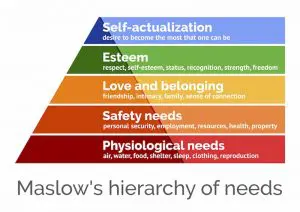In our recent webinar, Increasing Happiness and Engagement at Work*, we asked the questions: When have you felt the most proud, fulfilled and satisfied at work? What factors contributed to those feelings? The webinar attendees’ responses included:
- Achieving as a team, all working as one. So proud.
- Little things. I was able to help a colleague who was struggling. (I thought it would be the big stuff!)
- Solved a really tough problem – no one else recognised it but I knew it was important.
- Laughing together because we all get it.
- Building relationships over time.
- Getting through a risky/dangerous time together. Wasn’t fun but meant so much.
There were common themes in these answers, including the feelings of pride, fulfilment and satisfaction that people derive from communication and connection (communities of colleagues), self-esteem (being recognised for our achievements and efforts, in various ways), and self-actualization (being able to express yourself creatively).
Employees have needs, expectations and desires for what they hope to achieve at work, just as they do for their home life, sports teams, social activities and other facets of life. Maslow’s classic hierarchy of needs helps us to understand this. People are motivated to achieve certain needs, and some needs take precedence over others. Our most basic need is for physical survival, and this need often motivates our behaviour. Once that need is met, the next level up is what motivates us, and so on.

An employee describing their needs at work, consistent with Maslow’s hierarchy, might be heard like this:
Self-actualisation: ‘I use my full potential at work. I fully express myself’
Esteem: ‘I am achieving something. I am using my skills’
Belonging: ‘I have a friend at work. I am relevant to the enterprise’
Safety: ‘I feel safe at work. I am not harassed’
Physiological needs: ‘I get paid enough’
Maslow pointed out that most behaviour is multi-motivated and that “any behaviour tends to be determined by several or all of the basic needs simultaneously rather than by only one of them”. Hopefully, at work, people’s basic needs are met and they can focus on growth needs, which stem from a desire to grow as a person. Our standards of living are improving progressively over the decades, as are health and safety, workplace values and conduct expectations at work, so that self-actualisation is a realistic goal for many people.
Valuing the Intangible Needs of Human Beings
At the same time, over the last two decades, the ways businesses interact with and meet the needs of their stakeholders, and the types of needs served, have changed, keeping pace with the development of new technologies.
Each new business model that has emerged has its own scalability, operating efficiencies, and ways of relating to people. The adoption of cloud, social and mobile technologies have tested some people’s understanding and experience of connection, while others have found that technology opens up new ways of bonding, sharing ideas and meeting the intangible needs of human beings, which sit at the top levels of Maslow’s hierarchy.
New technologies, including online forums for communication and skills sharing, facilitate communities between friends, colleagues, potential mates and people who have specific things in common (belonging). They enable people to recognise each other’s value, whether in product rating of ‘likes’ on social media (self-esteem), and they allow people to express themselves creatively and develop new careers (self-actualisation).
Why Happiness and Engagement Matter
Thinking about the needs of employees is not just ‘nice to have’, if you are seeking a productive, engaged and loyal workforce. Research proves that a positive mindset has clear, positive consequences for goal achievement, and being happy is correlated with better performance and better productivity. Inspired employees are twice as productive as satisfied employees, and three times more productive than dissatisfied employees.
Autonomy – the feeling that I have some ability to determine or influence what happens to me – is also important. Employees who feel autonomy have higher job satisfaction (+10%), perform better (+5%), and are more innovative (+8%). Employees’ engagement with the workplace is another indicator of productivity. Organisations with a high level of engagement report 22% higher productivity, and group cohesion is positively related to the overall performance of the organisation (see research citations below).
How Do We ‘Make’ Our Employees Happy?
Gurus have offered answers to similar questions for millennia… and the human race still seems rather angry and dissatisfied! However there is much that employers can do to help.
Positive psychology and the science of ‘flow’ have a lot to offer here. Positive psychology focuses on building positive qualities, rather than focusing on repairing the worst things in life. It posits that, to enable people to thrive, we need to promote strengths instead of focusing on weaknesses, failures and ‘areas for improvement’.
A prominent writer in the positive psychology field, Mihaly Csikszentmihalyi explains in his excellent book ‘Flow‘ that we experience flow in those moments when the challenge we face is perfectly matched to our capabilities. Then our work ‘flows’ without much effort, as we are ‘in the zone’. Essential to achieving flow is minimal distractions, clarity of understanding of the task and its good ‘fit’ with our skills. Interestingly, flow is more enjoyable in an interdependent group, such as a functioning work team, than working by yourself.
The Five Keys to Happiness and Engagement
There is a fundamental irony in seeking to be happy and make others happy: that effort seeking happiness may not actually help. Instead of striving to achieve happiness as an outcome – something to be attained, like a possession – we should seek to cultivate skills which allow us to enjoy the good times and take the bad times in our stride.
Dr Vanessa Buote wrote that “one of the misconceptions about happiness is that happiness is being cheerful, joyous, and content all the time; always having a smile on your face. It’s not – being happy and leading rich lives is about taking the good with the bad, and learning how to reframe the bad”.
Instead of chasing happiness and oversimplifying it, let’s understand happiness as a ‘means’ not an ‘end’. It may sound clichéd, but the journey is where happiness dwells, not in an end goal. People feel most happy when they are enjoying the present moment, engaged in a meaningful project, and working toward higher goals – not when they are preoccupied in making themselves feel happy.
So how can we cultivate such a mindset in our employees, to increase happiness and engagement?
In part two of this blog, we will explore in more detail the five key elements which science proves are consistent with higher happiness, engagement and satisfaction at work:
1. Autonomy – I bring a positive attitude and open mind to work; I can influence my experience of what happens.
2. Mindfulness – I stay present, calm and true to myself.
3. Communication – I welcome feedback as a learning opportunity; I am not afraid of conflict.
4. Purpose – My own purpose is aligned with my organisation’s; I have integrity at work.
5. Gratitude – I notice and appreciate the good things.
Until next week!
About Rose Bryant-Smith


*You can watch Rose’s webinar “Increasing Happiness and Engagement at Work” on-demand for free.
Please contact Rose for an obligation-free, confidential discussion on issues at your workplace.
Select Research Citations
Mihaly Csikszentmihalyi: Flow(2011) and his excellent Ted Talk
Goal achievement: Burnette, Jeni & O’Boyle, Ernest & M Vanepps, Eric & Pollack, Jeffrey & J Finkel, Eli. (2012). Mind-Sets Matter: A Meta-Analytic Review of Implicit Theories and Self-Regulation. Psychological Bulletin. 139.
Productivity: Andrew J. Oswald, Eugenio Proto, and Daniel Sgroi, ‘Happiness and Productivity’, Journal of Labor Economics 33, no. 4 (October 2015): 789-822.
Autonomy: Gensler (2013), 2013 U.S. Workplace Survey: Key Findings
Inspired vs satisfied employees: Harvard Business Review (2015)
Engagement: Harvard Business Review (2013) and ‘Team structure and team performance in IS development’ Heng-Li Yang Jih-Hsin Tang, Information & Management, Volume 41, Issue 3, January 2004, Pages 335-349
Group cohesion: ‘Team structure and team performance in IS development’ Heng-Li Yang Jih-Hsin Tang, Information & Management, Volume 41, Issue 3, January 2004, Pages 335-349



